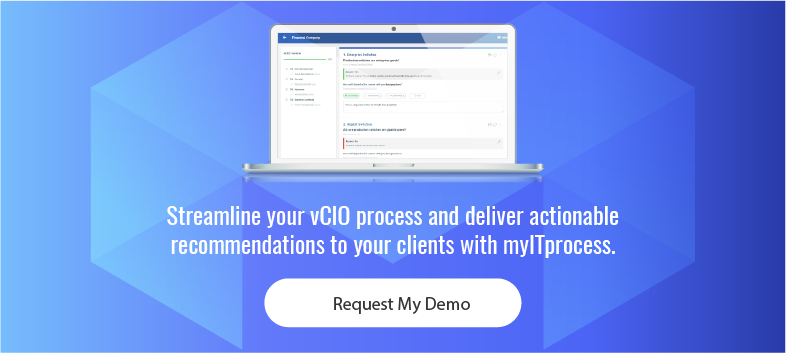Is your MSP a Technology Success Practice (TSP)? A TSP understands the challenges and opportunities for building a strategic relationship with clients and focuses on the client’s success through the proactive management of technology. The vCIO role is one of the more important parts of a Technology Success Practice. The reason for this is because clients will take recommendations from someone with which they have a business value-added relationship much more easily than from someone who they see as ‘just a techie’ or ‘just a salesperson’. But the vCIO can’t do all of this on their own; they need their secret weapon, aka the Technology Alignment Manager (TAM) role.
Why TAM is the Secret Weapon
Why is the TAM role so important to the technology success process? While a vCIO manages the business relationship and goals of each client, the TAM is instrumental in maintaining the Standards Library and aligning customers to those standards.
What is a Standards Library? It is a questions list of technical and IT compliance standards that lets you determine the status of all elements of your clients’ technologies. While other employees and roles attend and contribute to the Standards Committee meetings, the TAM has a ground-level view of how those standards are applied at the client site, and can be incredibly helpful in creating impactful reviews. Those reviews are then completed on site, generally once a month, and the TAM is the one gathering all the information needed to complete it. On the surface, it may seem like all the TAM is doing is answering yes/no questions. And in a way, that is correct, but the impact of those questions is so much larger than it seems at first glance.
We at TruMethods often recommend a vCIO make three types of recommendations: strategic, end of life, and research-based. How can a vCIO make a research-based recommendation to a client without any research being completed? TAMs are those researchers. They are the ones that provide that valuable information on which vCIOs make many of their business assessments. A vCIO cannot live up to their full potential without the TAM process backing them up. Think about it this way; a TAM is similar to when you go to the doctor and talk to a nurse or a nurse practitioner. They take your blood pressure, ask you why you’re at the doctor’s office that day, get your height and weight, and gather pertinent information for the doctor.
The vCIO is like the doctor that comes in and helps to assess the situation, and they use the information the nurse gave them to give a proper diagnosis. If the doctor recommends surgery and you as the patient agree to it, the surgeon is the one who actually goes in and fixes what’s wrong, just like the project team would. Think about how much more relaxed a regular General Practitioner’s office is compared to an Emergency room. This is the same as comparing reactive project work to a proactive MSP.
How the TAM Assists the vCIO
Most decision makers that vCIOs meet with are going to be business owners. They don’t have time for anything that is not concrete. While not everything will be mitigated by addressing logical issues, it certainly goes a long way in convincing a type-A, fact-oriented person (as business owners usually are) to do something. The TAM is gathering those facts for the vCIO, who translates them into business and personal ‘pain’ the client is feeling. Pain is part of the framework prospects can use to simplify and clarify the decision-making process. The goal is to have prospects view their current IT situation differently. Here are a few examples of how to phrase a recommendation to a client by addressing logical pain.
“We found that this switch was not compliant in this way, it’s going to impact your business in “x” way, therefore we want to replace the switch.”
“We found that you don’t have a password policy in place, this leaves you open to security risks, therefore we want to talk to your employees about password policies.”
Gaining Command
Perhaps most importantly, the TAM role will help the vCIO have command over a client’s environment. You want everything that you can control for the client to actually BE in control. Without gathering information and checking things regularly, there’s no real way to know if you are actually compliant. Without compliance and a process for checking compliance, you and your clients are not secure!
Our myITprocess software tool can be utilized as a client decision-making engine and to build a repeatable, high-value vCIO process. It provides TSPs with the opportunity to offer clients a strategic outlook on their business. The overall goal of a TSP is to give clients succinct and appropriate information for them to make decisions on their technology needs, and the TAM process helps clients do that in a big way.


